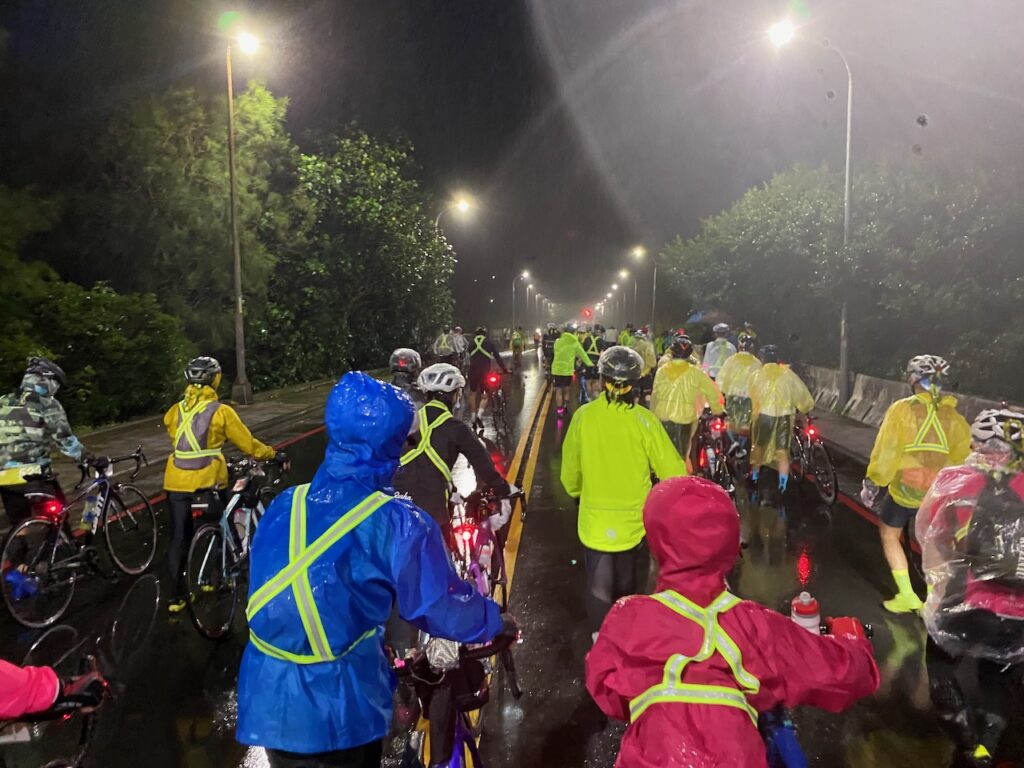
I signed up for the Two Towers in One Day Challenge in Taiwan again in 2022 and successfully completed the 520 km challenge in 26 hours. Here is how I did it.
Setting a Very Firm Target
I’ve set a very firm target for myself this year. I aim to complete the ride, regardless of how long it takes. If I can finish within 28 hours, I’ll be awarded a trophy, but that’s not my main focus. My primary goal is to finish it this year, even if it takes 35 hours or more. At the very least, I’ll have a record on Strava. I anticipate getting sleepy towards the end of the challenge in Pingtung but quitting is not an option. In the worst-case scenario, I might have to take a short nap in those convenience stores.
Supporting Services
To enhance my focus on cycling during the challenge, I opted for a support service package offered by XiaoChu, a friend who operates a company providing cycling tour services. This comprehensive package covers logistical aspects such as reaching the starting point before the event, supply stops during the ride, and the return trip to Taipei. Additionally, in the unlikely event that I cannot complete the ride, there’s the option to safely transition to the hotel at the destination by hopping on one of the support cars. I’ll delve into more details on how these support services played a crucial role in helping me complete the ride later.
A Proper Bike Fitting
Last year, I only made it to Tainan, and some issues emerged after long-distance cycling. My shoulders and elbows hurt because I relied heavily on them to support my body weight when fatigue set in, causing my posture on the bike to deform. Additionally, I experienced persistent lower back pain after cycling for more than 70 km. My forefeet were squeezed to the point where I couldn’t feel my fourth toes. Long-distance cycling serves as a stres test on my bike fitting.
As for the lower back pain, I initially attributed it to my own mistake of over-inflating the tires after a pinch flat from a pothole. However, after delving into more research, I identified the main causes and their solutions. According to a video by the Road Cycling Academy, it was a pair of muscles in my lower back, the Quadratus lumborum, that became victims of overloading. According to Neill Standury, the bike fitting expert in the video, I learned that these muscles play a crucial role in stabilising the pelvis during pedalling. Excessive rocking of the pelvis, caused by factors such as the saddle set too high, cleats positioned too forward, crank arms too long, or the Q-factor of the pedals being too narrow, can lead to overloading of the Quadratus lumborum. This can be confirmed by having eh pain subsided quickly after getting off from the bike and allowing these muscles to rest.
In my case, the culprit was the saddle height. Since lowering it, the lower back pain issue has significantly improved. It tends to occur only when I exert more effort for increased speed over an extended period. However, the discomfort fades away if I ease up on the pedalling without the need to a complete stop. By managing my pace, I can delay the onset of the pain.
Lowering the saddle also addressed another issue — the problem with my forefeet being squeezed disappeared completely. With the saddle too high, my toes had to point towards the ground beyond the 3 to 4 o’clock position with each pedal stroke. Unintentionally, I was pushing my feet into the toe box of my shoes, squeezing my toes together and restricting blood flow into my fourth toes. The lower saddle rectified this, ensuring my feet are more level and can rest on the pedals at a proper angle without any discomfort or squeezing of my toes.
But what about the power output? Does lowering the saddle mean sacrificing power? Not necessarily. Interestingly, a higher saddle doesn’t guarantee a better position for maximising power output. Our muscles contract to pull our bones and exert force on the pedal. As illustrated on this page – Force of Muscle Contraction, the maximum tension of our muscles is found at the middle of the contraction. As a muscle contracts to its end of range, the tension decreases rapidly. Therefore, to achieve the maximum force, we want our muscles to operate at the middle range of contraction. A higher saddle does not necessarily translate to increased muscle power output.
For my elbows and shoulders, their role is solely for steering, not supporting my body weight. It’s crucial not to cock my elbows, as doing so would transfer all impacts directly to the joints, especially on uneven roads. Keeping the arms slightly bent allows the tendons and muscles to absorb most of the impacts. Lowering the saddle has the added benefit of shifting my center of weight away from my arms. This adjustment makes it easier to maintain my position with comfortable bent arms.
The Rikulau Master V9
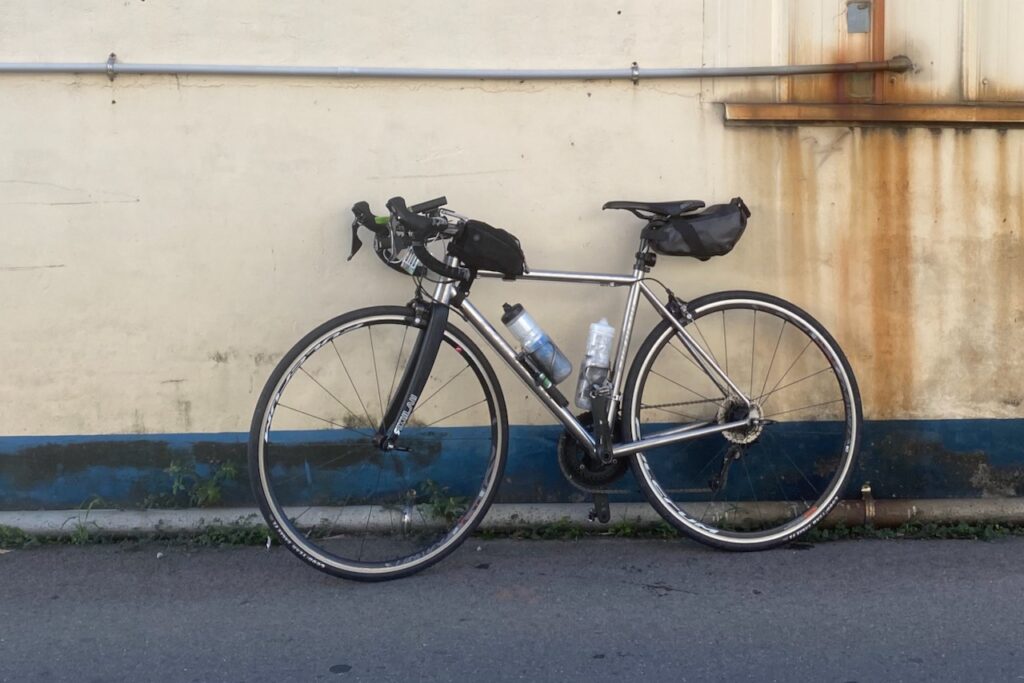
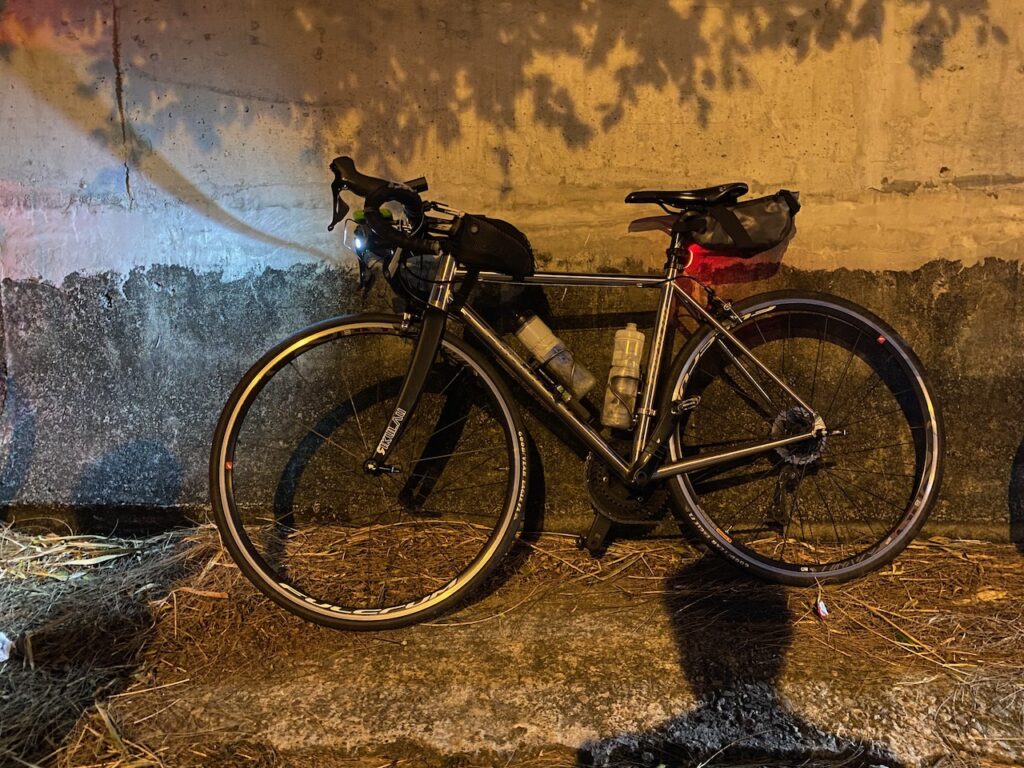
This year, I used the Rikulau Master V9, The V9 (Vulcan) features Rikulau’s proprietary seamless tubing made with Custom C465 stainless steel by Carpenter Technology, USA. Custom C465 stainless steel is specifically developed for aerospace and marine applications. The general corrosion resistance of the alloy, tested with exposure to 5% neutral salt spray at 35°C, resulted in no corrosion after more than 2,000 hours of exposure.
The tube-making and heat treatment processes are conducted in Taiwan. Achieving a balance in tensile strength (approximately 1800MPa) and good ductility is accomplished by selecting the appropriate age-hardening heat treatment temperature according to Rikulau’s introduction to this bike.
This is the first road bike I intend to own and ride for decades. I have travelled with it to many places in Taiwan and have already developed some emotional attachment ot it.
I believe a well-maintained drop-bar road bike with proper sizing should be sufficient. While a flat-bar road bike might be acceptable, it offers only two holding positions at best, limiting our ability to rotate our position. This inflexibility may lead to overworked muscles, especially considering we’ll be spending more than 24 hours on the bike.
Logistic Preparation
The challenge began at midnight at Fugui Cape and was expected to last around 24 hours, encompassing two night periods. To optimise sleep opportunities, Xiaochu booked a hotel in Tamsui for us to rest after dinner. We were then transported to the starting point around 11:00 pm. Xiaochu strategically set up supply stops every 70km, allowing us to refill our bottles and snack pouches. Maintaining a consistent intake of food is crucial, as we’re expected to burn around 8,000 Kcal during this endurance period. After cycling for 40 km, I already felt so hungry and I found myself eating a piece of bread, on the saddle, that I had saved from the afternoon.
In the darkness, spotting our own supply cars became a challenging task. Xiaochu addressed this by broadcasting the supply cars’ live locations on Velodash, proving to be immensely helpful, especially when they couldn’t park at the exact planned locations due to occupancy by other supply cars. When I was approaching the supply stop, I could just launch the app to spot them among all the support cars or the other teams.
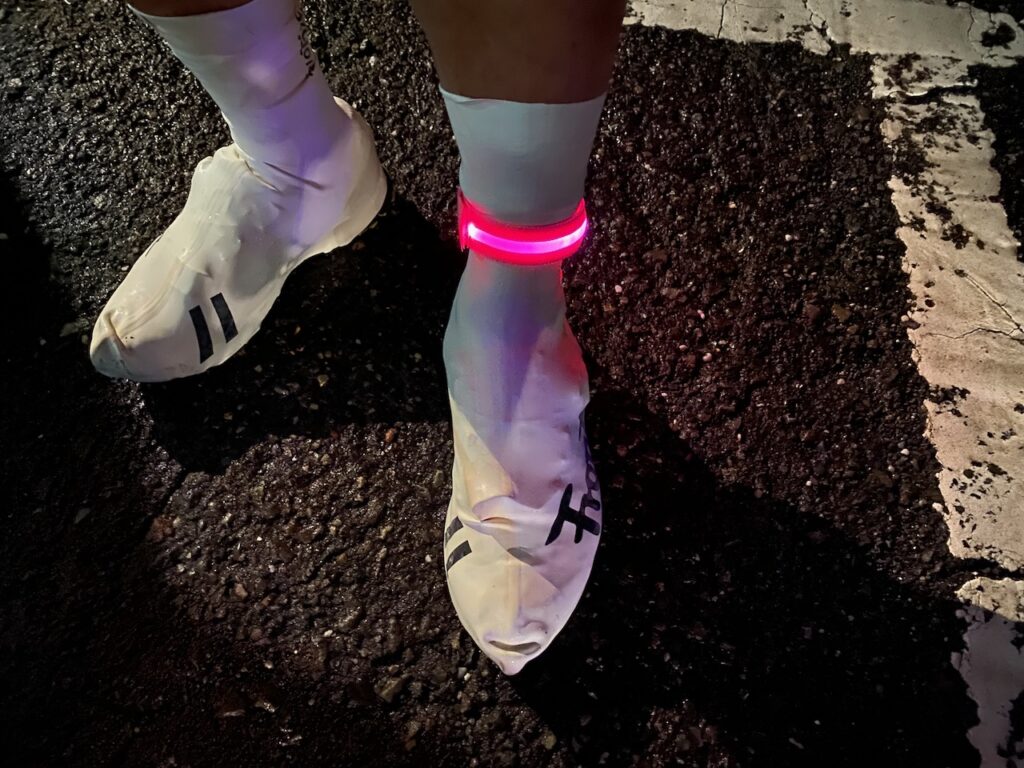
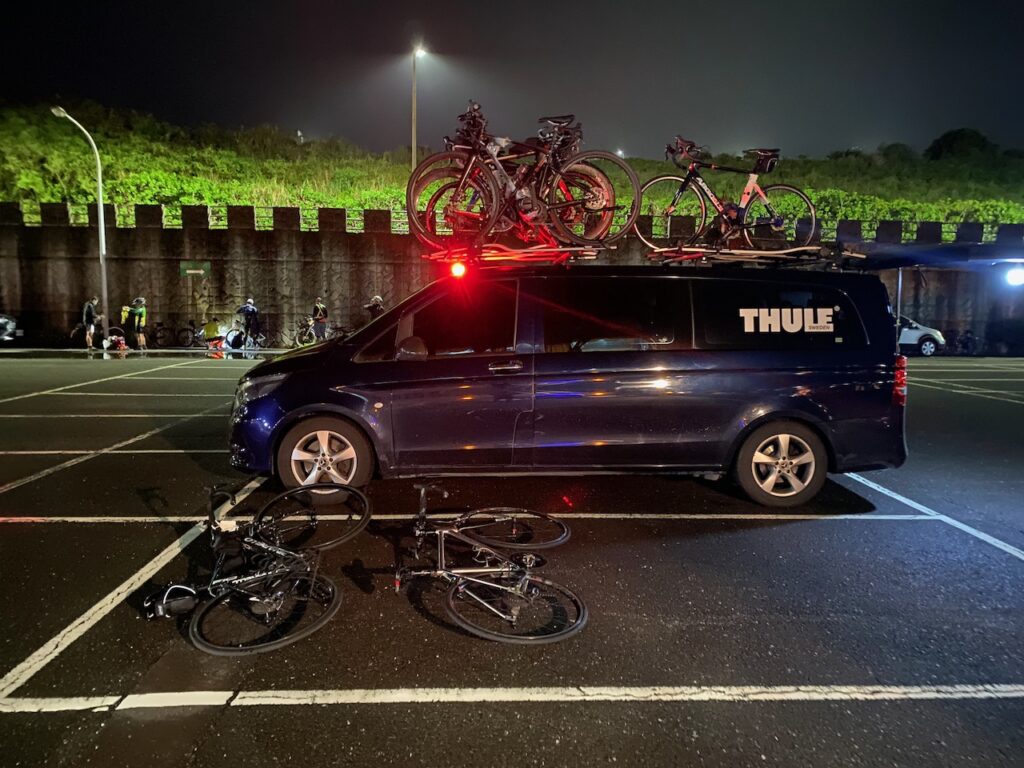
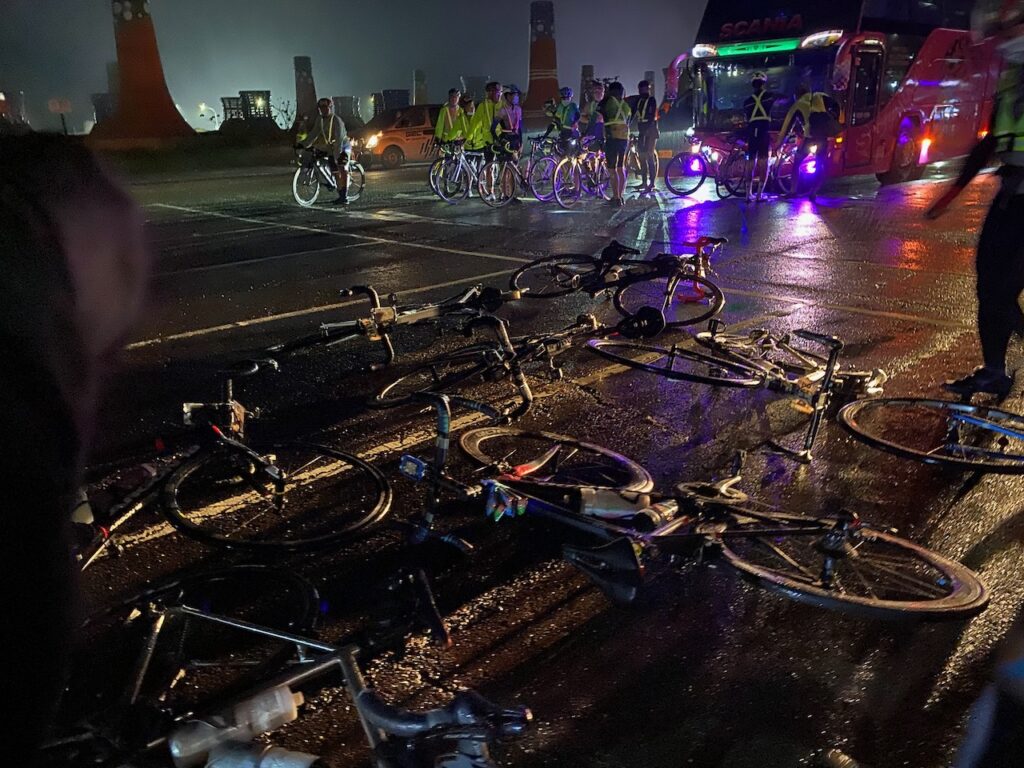
Xiaochu provided glowing bands for us to wear on our ankles or arms. This simple measure ensured that the supporting staff could easily identify us from a distance and guide us to the cars at each stop.
The Starting
We encountered some drizzles at Fuguijiao Lighthouse. Fortunately, my jacket was sufficient to keep my body core dry. The roads were wet, with a long stretch of participants occupying the entire lane. I proceeded cautiously, aware that even a small accident could potentially trigger a mass crash, leading to the premature retirement of many participants from the race.
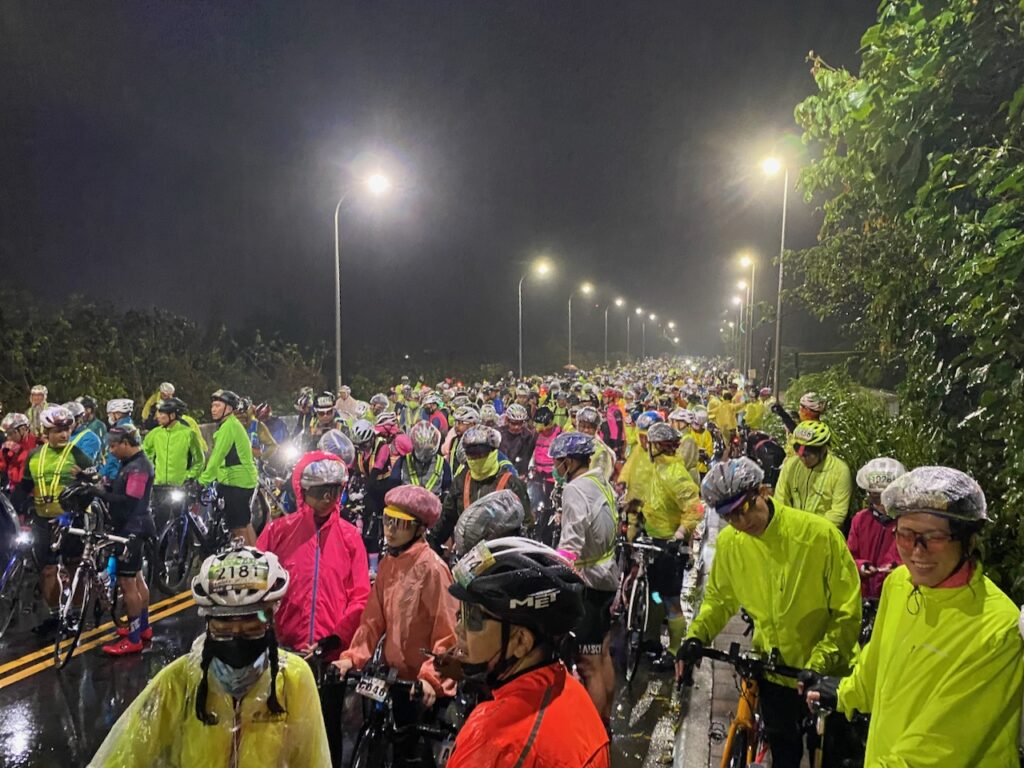
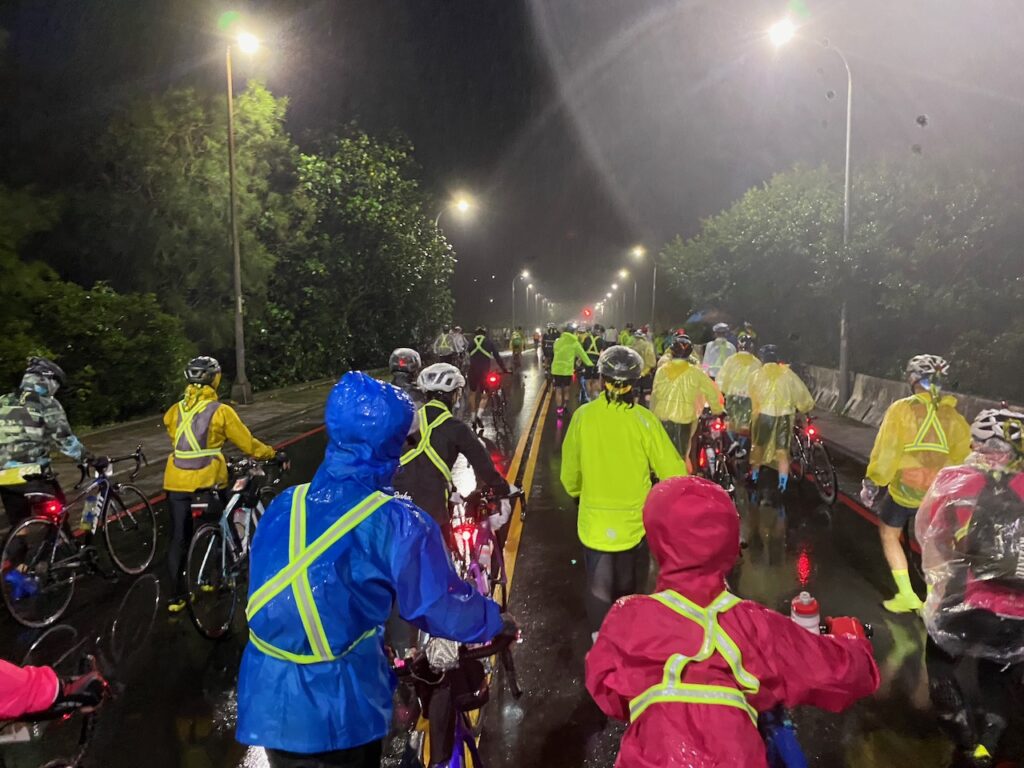
A Spontaneous Team Formed
It became completely dry when we reached Bali District at 40 km. I made a brief stop to remove my shoe covers, which I had worn to prevent rain from wetting my feet. Surprisingly, they were wet inside, but not from rain. Instead, it was the sweat from my feet condensing on the shoe covers, which were made of the same material as swimming caps. Fortunately, I was able to remove them before my feet got drenched by my own sweat. Soon, the moisture was whisked away by the wind, and I continued cycling comfortably with dry feet.
I must say, we were blessed with the best weather conditions this year. A very strong tailwind propelled us, and everyone was cruising at over 40 km/hour, making the ride exceptionally enjoyable. Soon, I recognized my friends Jeff and Hsunyi, along with their friend Abby, all identified by Xiaochu’s glowing bands as participants in the support services. Realising our paces were quite similar, we decided to stick together and took turns leading the group.
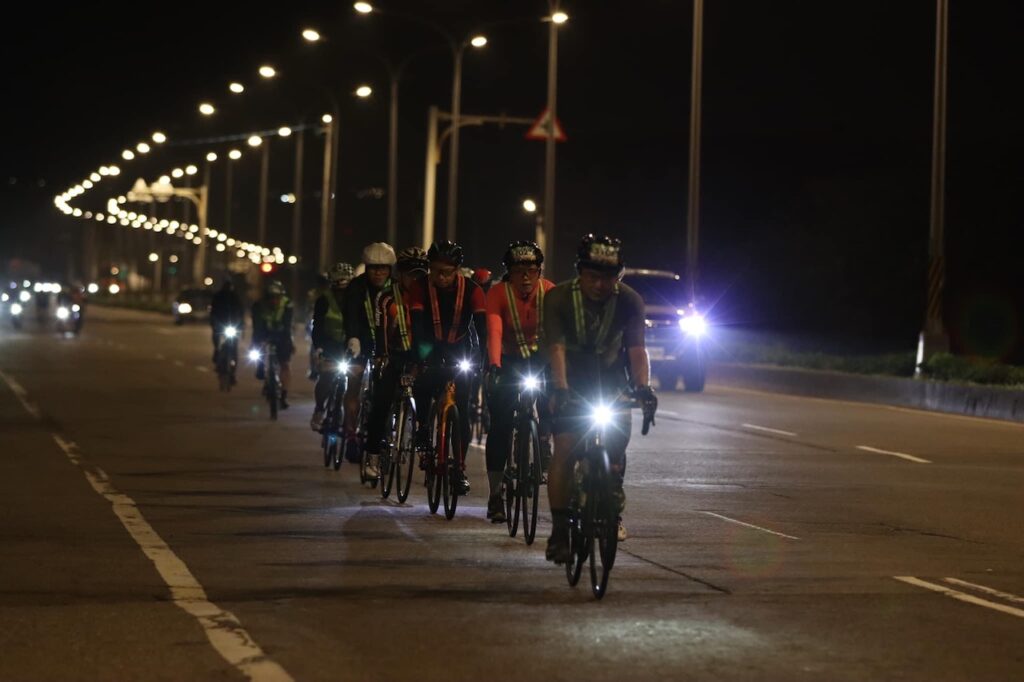
BCAA to Rescue
At the 2nd supply stop, my legs started to show signs of cramping. xiaochu offered some BCAA pills, a type of amino acid that our body uses to build proteins. It worked like magic; I never experienced muscle cramps again. Additionally, there was an unexpected benefit: my lower back pain. Despite adjusting the saddle height, I had only managed to delay its onset. I expected it to resurface at some point, but to my surprise, it never occurred throughout the entire ride. I attribute this relief to the BCAA. If you are facing a similar problem, it’s worth considering trying BCAA supplements — they’re just supplements, after all.
Every Minute Counts
As the morning broke, we decided to take an extra breakfast top stop due to our good progress. Approaching the Wuqi district of Taichung, known for its numerous traffic lights, we opted for a longer route to the coast to bypass the lights and potentially increase our speed. Upon meeting Xiaochu at the Wuqi stop for the planned breakfast, he informed us that it was a wrong call, as other participants who maintained a similar pace had already passed by sticking to the official route. Anyway, the breakfast the team prepared for us was delicious. Nothing extravagant — just some soybean milk with a sandwich from a local food store. The variety of tastes provided a welcome break from energy gels and lifted our spirits.
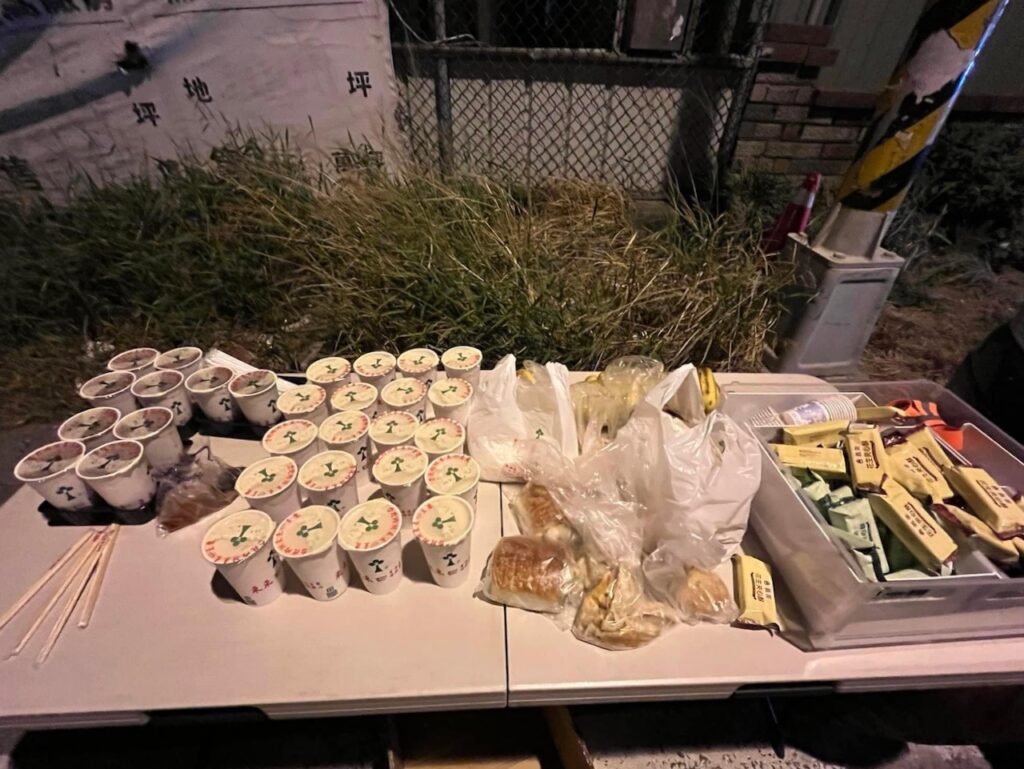
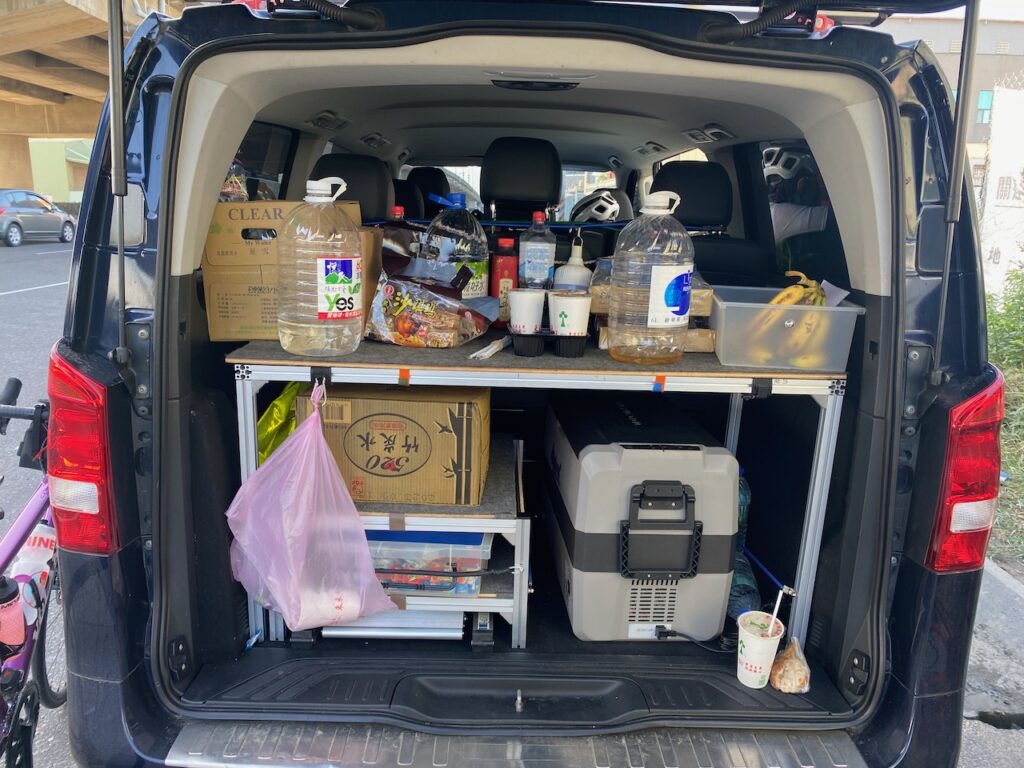
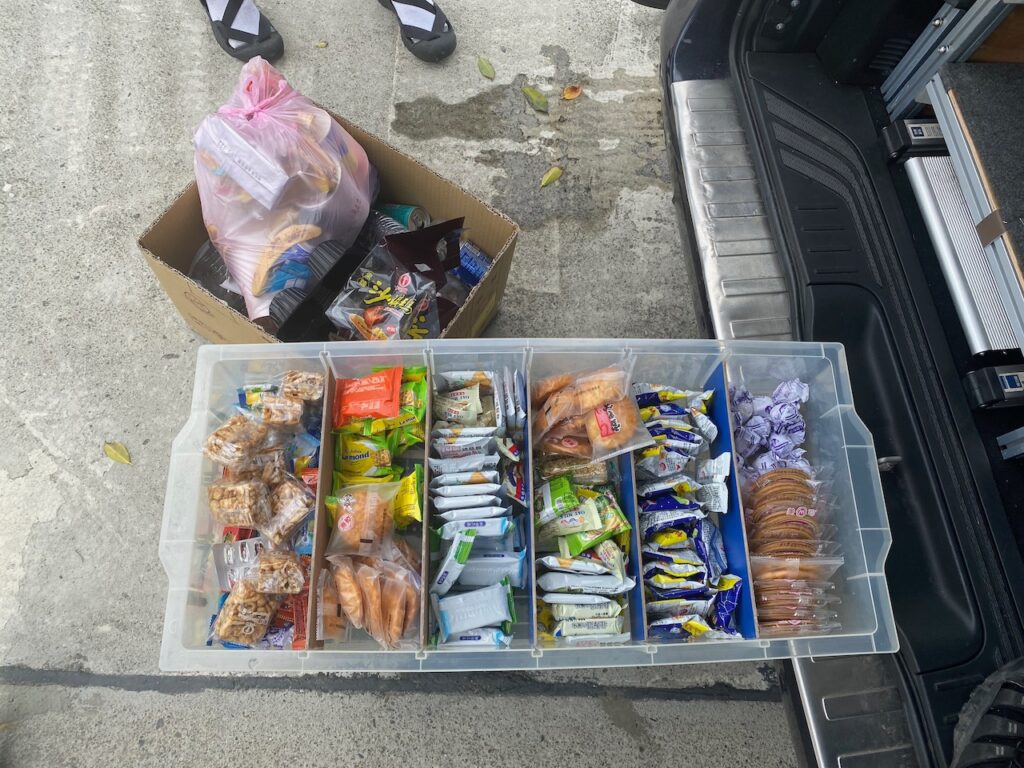
He also delivered another piece of news: our chance of finishing this challenge within 24 hours was slipping away. While it wasn’t our initial target, Xiaochu’s support team was coordinating with participants aiming to reach Eluanbi within 24 hours. This meant our windows for supply stops would become smaller. If we were still on the road after 24 hours, we would have to rely on convenience stores for supplies. I found this to e a very reasonable arrangement, considering the support team’s need to take us back to Taipei the next morning after working for such a long hour. They deserved some good rest.
Cadence at Natural Frequency
It is said that we exhaust the carbohydrate stored in our body after two hours of exercise, and our gut might not be able to digest food quickly enough to replenish the sugar in our body. To tap into my ample body fat reserves, I cycled at lower gears with a higher cadence, maintaining over 100 rpm.
Something fascinating occurred. It seemed as though my legs were moving on their own, requiring minimal effort to pedal. While lower gears naturally result in lower resistance from the pedals, I could also feel that my legs were lighter at this cadence. In hindsight, I believe I was cycling at the natural frequency of my legs.
Ever wonder why a mechanical metronome can swing for such a long time after just a couple of windings? It’s because it swings at its natural frequency, requiring very little energy to keep it going. The same principle applies to our bodies. Another example is when we walk; our legs move like a pair of pendulums at their natural frequency. However, when we run, our legs have to move at higher frequencies, working against the natural frequency and causing more fatigue after covering the same distance. Pedalling is also a periodical motion, and I discovered the existence of a natural frequency during this long ride. When can leverage this phenomenon to achieve maximum energy efficiency especially when our muscles are tired.
Companion and Support Make a Difference
At Tainan, Abby and I were still maintaining the same pace, but we had dropped Jeff and Hsunyi. We decided to treat ourselves to some snacks at the first 7-Eleven we spotted in the city. The shopkeeper generously provided each cyclist with an extra hard-boiled egg for free to accompany the instant noodles.
Last year, I felt lonely and struggled with lower back pain, wasting a lot of willpower on meaningless self-talk. Questions like,
‘Is it a good time for a break?’,
‘Should I stop at this 7-Eleven for some snacks?’,
‘What should I buy?’,
“Maybe not this one because there are too many people.”,
“But what if the next one is too far away?”,
“Maybe it’s going to be the same so why not just take a break while I have one around?”, “Should I worry about the last leg from Kaohsiung to Eluanbi?”,
“What if I collapse?”.
This year, it was wonderful to have someone to chat with, especially when sharing the same goal. With Xiaochu’s well-planned supply stops, I could focus my willpower solely on cycling. The next stop is 70 km ahead, so I just didi ti. The food he provided wasn’t extravagant, but it felt good to have someone prepare for me, and I was pleasantly surprised with some local delicacies. Xiaochu also briefed us on our progress, providing crucial information even though it was a simple calculation. In 2020, during the Taipei to Kaohsiung Challenge, I got my progress and the maths wrong when I was alone. I almost failed to make it within the time limit.
The Real Start in Kaohsiung
By Around 19:00, we reached Pingshan Elementary School in Kaohsiung, the designated destination for the Taipei to Kaohsiung Challenge. Xiaochu’s team had prepared a simple yet delicious dinner awaiting us. Despite my continuous eating on the saddle, I devoured the meal and even went for two refills.
Having already covered 400 km with 130 km left to go, it felt like a real start to me. This marked the first time I ventured further south in such a long ride.
Kaohsiung, with its numerous multi-lane roads, resembled a maze to me, especially in the darkness. The organisers had some helpers stationed at significant junctions to guide us, but having your route loaded onto your navigation device is advisable.
We navigated through Kaohsiung smoothly, reuniting with Xiaochu at another supply stop. The excitement was palpable as everyone realised how far we had come. Another group of participants joined our ride for a while, as they weren’t entirely sure about the route. We welcomed the additional companionship.
The Confrontation by the Downhill Winds
As we approached Checheng, I felt my strength fading. The wind shifted as we headed southeast on the Pingtung Peninsula, making it harder to keep up with Abby, and soon I lost sight of her. Abby and I met Xiaochu again at a 7-Eleven, where they were ready to head directly to Eluanbi. It was our last chance to get in the car, but we both decided to press on with the ride. I advised Abby to ride at her own pace for a better time. Soon, I was dropped again.
The low hills of the Pingtung Peninsula directed the northeast wind upward and then funnelled it down at the west side from all directions – The notorious Downhill Wind – confronting us at the last 50 km. After enjoying a tailwind for so long, it was time to pay the price.
Slowly, I made it to Hengchun and Kenting Street. People in the Kenting night market cheered for us. A guy with a beer in his hand even gave me a push on the back. Oh, that was nice, even if just for a second.
Then came the last 8 km, and I found myself all alone. The Downhill Wind intensified. To add to the eerie effect, before the wind pushed you sideways, it gave you a warning with the rattling of the trees. Once, I almost got pushed to the opposite lane. In preparation for this part, I have undertaken a challenge from Taichung to Eluanbi a couple of months ago. Otherwise, I wouldn’t have had the nerve to continue. I knew the finishing line was there; all I needed to do was keep pedalling. However, the last 5 km seemed to stretch longer. I found myself speaking to myself, ‘Pedal! Pedal! Pedal!’
The Finishing Line
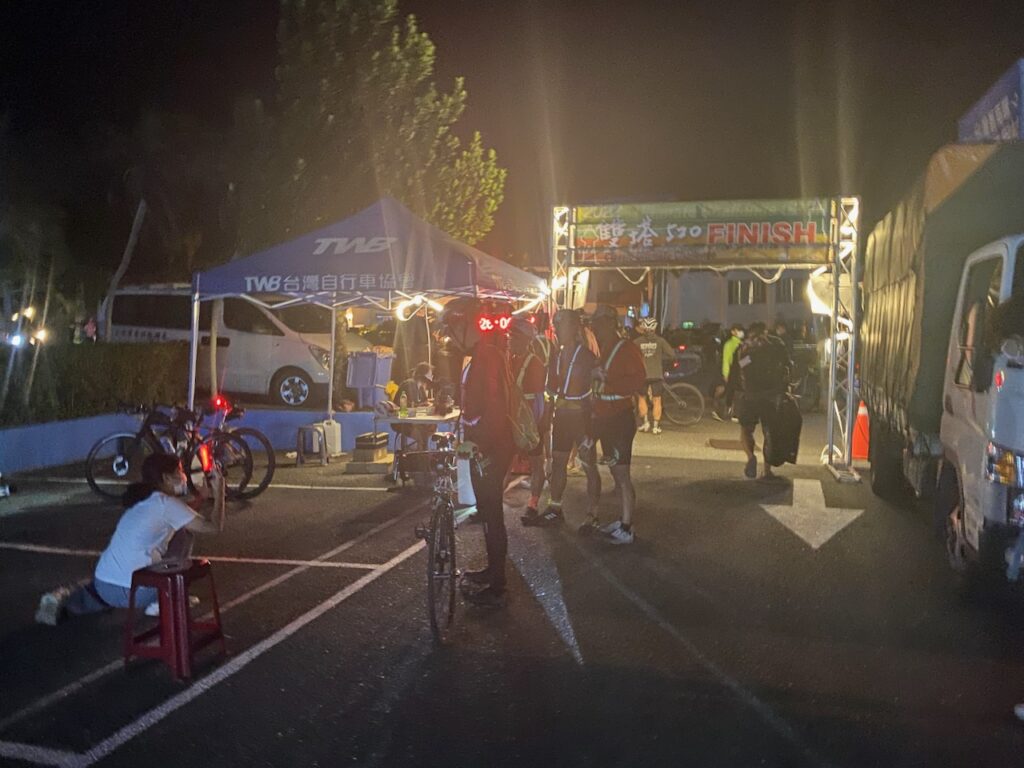

After too many moments of self-talk, I finally caught sight of the finishing line, which I initially doubted was a hallucination. I rolled my bike into the finishing gate and heard the beep of the computer recording my finishing time.
Xiaochu was there to greet me and take pictures. I followed the procedures to receive my certificate and trophy. It was 2:00 a.m., and I managed to finish this ride in 26 hours. The next morning, when I woke up, I learned that Jeff and Hsuny had also made it within 28 hours.
